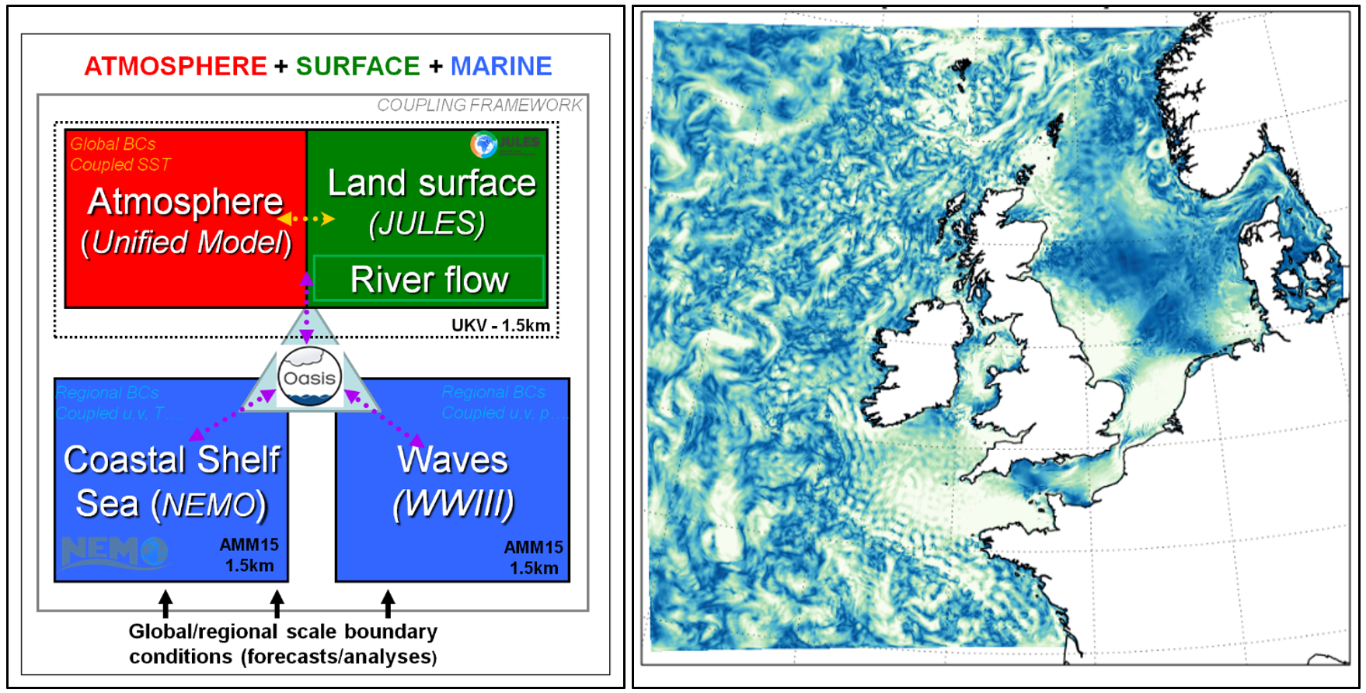Update on UK Environmental Prediction
July 2019 - New research on high resolution modelling of interactions between atmosphere, land and oceans published and planned by UK Environmental Prediction collaboration.
The latest research in UK Environmental Prediction was discussed at a workshop in Reading with over 50 scientists from collaborating institutes in June 2019.
The UK Environmental Prediction initiative is a national collaboration led by the Met Office, Centre for Ecology & Hydrology, National Oceanography Centre and Plymouth Marine Laboratory. It develops and evaluates the UK’s first fully coupled regional prediction system at kilometre scale, encompassing atmosphere, ocean, wave, land surface, and biogeochemistry model components and their interactions. The aim of the initiative is to enable multi-disciplinary research on Earth system processes at high resolution and to improve future operational applications.
"The Met Office is investing in UK Environmental Prediction research to help us develop our prediction and warning systems so that they continue to improve in their skill and in the range of actionable information that they can provide to users. The research that we are doing today may pull through to operational use, for both weather and climate prediction, and deliver further benefits from computing and observational investments through the 2020s and beyond." Prof. Simon Vosper, Director of Meteorological Science, Met Office
Details on the regional coupled prediction system were recently published in a Geoscientific Model Development journal article [1]. In brief, we are conducting research using a system which links together the Unified Model atmosphere, JULES land surface, NEMO ocean and WAVEWATCH III wave models, all defined over a UK-centred domain shown in Fig 1 with a 1.5 km horizontal grid spacing. Recent research publications using the regional coupled system discuss the influence of ocean waves [2] and air-sea interactions [3] on the quality of ocean forecasts.

Fig 1: UK Environmental Prediction regional coupled system model components (left) [1]. Snapshot of simulated surface ocean currents from the NEMO ocean model with 1.5 km grid spacing, showing high resolution features such as internal tides and ocean eddies (right).
The workshop gathered together a broad range of researchers from the Met Office, NERC centres, academia (representing 8 different UK universities), government agencies including the Environment Agency and Public Health England, and consultancies, to review latest research progress across the collaboration. One of the exciting aspects of working with coupled systems, illustrated during the workshop, is the need to join together and share different perspectives and expertise from across weather and climate, marine and hydrological science disciplines. This led to a number of new cross-disciplinary links and networks being formed.
Most time during the workshop was spent by participants working in small multi-disciplinary groups to develop proposals for research and practical user-focussed applications. The discussion within the groups focused on how to improve modelling and observation capabilities, closing gaps in the scientific knowledge and demonstrating the skill of coupled prediction tools through evaluation experiments. The working groups were focused around three selected areas:
- Estuarine and coastal environments
Project proposals include work to better simulate and assess the transport and evolution of pollutants from land to ocean, and work to represent the highly detailed estuary and coastline geographies better within modelling systems. - Regional coupled prediction for environmental change
Project proposals include work to characterise the impact of representing the interactions between atmosphere, land and oceans on the present-day climate in the UK and in other regions such as south-east Asia where air-sea interactions are known to be important. - Concurrent and combined natural hazards
Project proposals include work to assess the vulnerability of regions in the UK to worse-case scenarios when natural hazards from multiple sources combine and potentially interact, e.g. when strong storms, large waves, high tides, high river flows and saturated land occur at the same time.

Fig 2: Twenty academics from 8 different universities, 13 researchers from NERC centres and 15 Met Office scientists worked with six end-users from public agencies and a consultancy on project proposals during the UK Environmental Prediction workshop in Reading, 27-28 June 2019.
Some of the new proposals developed during the workshop will be undertaken as research projects within the current UK Environmental Prediction collaboration, while others will form the basis for new funding proposals among the wider community.
For further information on the workshop outcomes and the UK Environmental Prediction collaboration, contact [email protected].
[1] Lewis HW, Castillo Sanchez JM, Arnold A, Fallmann J, Saulter A, Graham J, Bush M, Siddorn J, Palmer T, Lock A, Edwards J, Bricheno L, Martínez-de la Torre A, Clark, J (2019): The UKC3 regional coupled environmental prediction system. Geoscientific Model Development. 12 (6). 2357-2400. https://doi.org/10.5194/gmd-12-2357-2019
[2] Lewis HW, Castillo Sanchez JM, Siddorn J, King RR, Tonani M, Saulter A, Sykes P, Pequignet A-C, Weedon GP, Palmer T, Staneva J, Bricheno L (2019): Can wave coupling improve operational regional ocean forecasts for the north-west European Shelf? Ocean Science. 15. 669-690. https://doi.org/10.5194/os-15-669-2019
[3] Lewis HW, Siddorn J, Castillo Sanchez JM, Petch J, Edwards JM, Smyth T (2019): Evaluating the impact of atmospheric forcing and air–sea coupling on near-coastal regional ocean prediction. Ocean Science. 15. 761-778. https://doi.org/10.5194/os-15-761-2019





